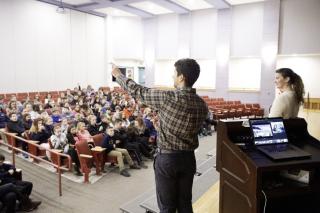Poland students get firsthand account from members of Mount Everest expedition

UMaine adventurers share their Himalayan trip with Whittier Middle School students
Poland students get firsthand account from members of Mount Everest expedition.
BY ERIKS PETERSONSSPECIAL TO THE SUN JOURNAL
University of Maine graduate students Peter Strand and Laura Mattas talk to seventh-graders at Bruce M. Whittier Middle School in Poland on Thursday about their expedition to study glaciers on Mount Everest. Daryn Slover/Sun Journal Buy this Photo
POLAND — Was it an adventure or scientific exploration?
This year’s UMaine-led expedition to Mount Everest was both, but Bruce M. Whittier Middle School students heard the word “adventure” uttered more frequently than the word “science” Thursday morning when student researchers Peter Strand and Laura Mattas talked about the international scientific expedition that took them to the Himalayas.
Strand, a UMaine doctoral degree candidate, and Mattas, who is working toward her master’s degree at UMaine, were members of a multinational of team of scientists and Nepalese researchers and Sherpa guides who collected data from glaciers, snow, water, sediment and rocks in April and May. The data is expected to provide real-time and historical information about climate and other factors which affect the world’s ecosystem.
The mission was supported by the National Geographic and Rolex Perpetual Planet Extreme Expedition to better understand earth’s critical life-support systems, part of the two organizations’ 65-year partnership exploring all facets of the earth’s geography.
According to National Geographic, the expedition set a world record as the most comprehensive single scientific expedition to the mountain in history, notable for the work done to drill the world’s highest ice core, at 8,020 meters above sea level.
The drill to collect the core was an off-the-shelf ice-coring instrument modified by UMaine’s Advanced Manufacturing Center. The samples collected will provide details about the chemistry of the atmosphere above 8,000 meters, according to National Geographic.
Paul Andrew Mayewski, director of the UMaine’s Climate Change Institute and professor in the School of Earth and Climate Sciences, was the expedition leader for the project, which involved 55 science partners.
While the team of scientists was on the mountain, they set up five automated weather stations, two of which are the world’s highest operating stations. They also conducted water tests, examined landmarks and studied the irregular jet stream pattern over the world’s highest mountain at 29,029 feet above sea level.
Strand and Mattas talked about the work like it was a day in a park.
Strand grew up in Yarmouth, admitting he was always “thinking of being outside” and “having an appreciation of the natural world around us.”
Mattas is from Glenville, New York, and got involved in school science programs, particularly chemistry, and wanted to “understand how chemistry impacts the natural system.”
Both started as engineering students at UMaine Orono but later switched to the Climate Change Institute and the School of Earth and Climate Sciences.
Mattas said that in April the team gathered in Kathmandu, Nepal’s capital. They took a 45-minute helicopter ride to the village of Lukla at 9,334 feet above sea level. From there, it was a 12-day hike to base camp at 17,514 feet where they worked for several weeks. The camp is one of two where climbers begin the ascent to Everest’s peak. There were hundreds of people there.
Strand talked about the various jobs, such as drilling ice cores where atmospheric gases are trapped and being able to measure percentages of those gases from thousands of years ago.
He also talked about the drones they launched, taking hundreds of photographs which were digitally “stitched together to create one big mosaic” of the glacial valleys below Everest.
“The expedition is just really the start of our science,” Strand said. “So we have a whole number of laboratory steps and this is where we really produce the data and this is what allows us to tell exactly how the climate is changing, how the biology is changing, how fast the glacier is retreating, how the weather is changing, and what the former composition of the atmosphere there was like.”
Whittier School Principal Shawn Vincent said David MacMahon of Poland, a member of the University Maine System board of trustees, invited Strand and Mattas to the school. The students have given a number of presentations on their work, including one last month at UMaine during a Climate Change Institute panel.
During that panel Institute Director Mayewski told the Maine Campus newspaper that “the very best thing about the work we get to do is that we can travel all over the world to fantastic places, bringing with us students who get to have life-changing experiences.” He praised students for their focus, explaining “you really are absolutely in your own world up there. It’s one thing to get up to these mountain ranges, it’s another to be able to think about what you’re doing and collect good science too.”
According to the Maine Campus report, Mount Everest and its glaciers supply 20% of the Earth’s water and if the glaciers continue to melt, and water quality continues to change, it will wreak havoc on the people living in the Himalayas.
In the November presentation, Strand said his biggest takeaway from the expedition is how fast the region is changing. “The glaciers are melting and being rearranged because of the warming mountains. This is why it is so important to deliver the message with our photos and accounts.”

